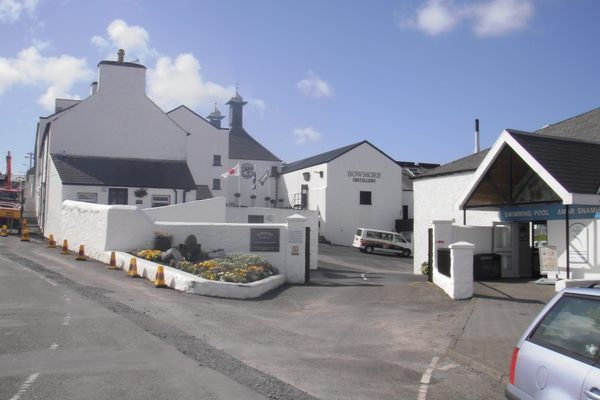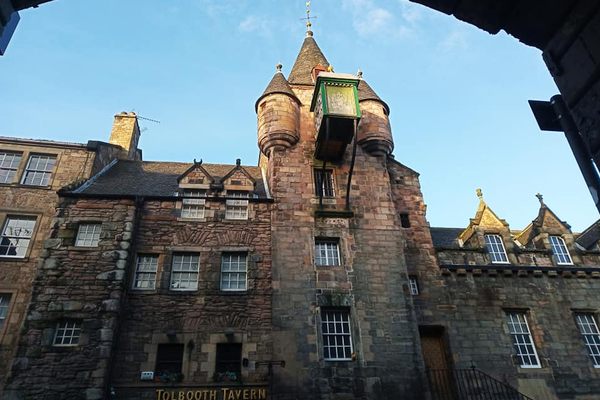The Lethal Lunch That Shook Scotland
From cold cuts to cold case.

Seventy-year-old John Stewart was the first guest to feel it. Awoken by nausea at 3 a.m. on August 15, 1922, he lurched to the bathroom and vomited violently. Some time later, the hotel’s servant found him back in bed, able to open his eyelids only by using his fingers.
Unmarried and an avid angler, Stewart had made the remote Loch Maree Hotel his summer getaway for the past 40 years, leaving management of his Glasgow cloth and yarn business to his partners. Nearly every day, he was out on the loch in pursuit of trout, his quiet ghillie oaring him in and out of tiny wooded isles, cradled by the ancient peaks of the northwest Scottish Highlands. This place, Stewart often remarked, was where he wished to die.
At 7 a.m., the hotel’s proprietor, Alex Robertson, a seasoned and respected innkeeper, checked on his infirm guest, who was apparently feeling better. “I asked Mr. Stewart if we would send for the doctor,” Robertson recalled later, “but he thought not.”
Awakening in another room, an elderly Dublin couple complained to each other of dizziness and double vision. Reluctantly, she remained in bed while he mustered strength to go out fishing. Down the hall, a retired London barrister pushed through the same symptoms, bathing, dressing, and staggering down to breakfast. He joked to Mr. Robertson that he felt drunk, but yes, perhaps it might be wise to wire a doctor.
When Dr. Knox arrived by car from nearby Gairloch, the barrister apologized for making a fuss, chuckling that he saw two doctors instead of one. But upstairs, Mr. Stewart had worsened and the Dublin woman was slurring, prompting the doctor to return speedily to Gairloch for backup.
Out on the lake, the Dublin man saw two trout jump when his ghillie saw one. Fishing nearby, Major Fearnley Anderson, a Seaforth Highlander on leave from his post in India, ignored his own ghillie’s growing signs of illness all afternoon, as effortlessly as he had ignored his wife Rosamund’s symptoms in the hotel room that morning.
At 9 p.m., Dr. Knox returned to the hotel with a professor of medicine who was in Gairloch on holiday. The news from Mr. Robertson was grim. An hour earlier, Mr. Stewart had died, the other three guests were worsening by the minute, and now there were two more sick guests: neglected Mrs. Anderson and a 22-year-old Oxford graduate, the beloved scion of an elite English family, who, despite scrambling a nearby mountain the day before, could move neither eyeballs nor tongue.

Before the doctors could do anything other than prescribe brandy and champagne, Knox was called to a cluster of huts nearby, the seasonal homes of the ghillies and other local workers. Here, Major Anderson’s ghillie, Kenneth MacLennan, complained of acute abdominal pain. Knox quickly prescribed a laxative, then rushed back to the hotel, where the Dublin woman expired just before midnight.
All night and over the next several days, they continued to suffer and die. Darting impotently from room to room, doctors bore witness to a near-uniform story of unstoppable decline: double vision, dizziness, droopy eyes and thick tongues, then a cascade of paralyses, from eyes and lips to larynx and diaphragm. Once they lost their speech, the patients communicated by writing, and when their fingers failed, by crude flailing. Their limbs jerked wildly, and they clutched at their throats, unable to breathe, conscious to the end.
Midday on Wednesday, another ghillie announced himself sick, bringing the total afflicted to eight. With the arrival of police, newspaper reporters, four more doctors and several coffins, a shell-shocked Mr. Robertson watched most of his 30-odd healthy guests speedily check out. The stately Loch Maree Hotel, formerly renowned for a brief visit by Queen Victoria in 1877, now faced infamy.
“The spirit of tragedy broods in the glens and haunts the hills,” reported one paper as word spread. Within a day, headlines of the incident were sowing panic across Britain. As the Scotsman delicately put it, “Scotland so rarely experiences so painful a sensation.” Shuddering over the running tally of deaths, near-recoveries, and relapses, readers everywhere agonized over one central question: What or who was responsible?
The medical team on site quickly ruled out encephalitis and poisoning by belladonna (known to affect the eyes), and they threw cold water on the media’s rushed diagnosis of “ptomaine poisoning” (common food poisoning): The symptoms at Loch Maree were far more severe. They agreed that the illness was likely food-borne, but what had these six guests and two ghillies eaten that the others had not?
Crowding into the hotel’s kitchen, the doctors immediately excluded dinner and breakfast, whose menus were uniform for all guests, leaving lunch the likely culprit. What, they asked the terrified cook, had she prepared for Monday’s lunch? Just what she made every day, she explained: sandwiches, wrapped neatly in paper packets for guests to take on their fishing, hiking, or driving jaunts, or departures by train. On Monday, they contained jam, cheese, leftover roast beef from Saturday’s dinner, and ham and tongue from Sunday, which Mr. Robertson had carved himself. And, of course, potted meat.
What sort of potted meat? On this point, the cook was unsure. In late June, the hotel had purchased two-dozen jars of four different varieties from Lazenby’s of London: chicken, ham, and turkey, all mixed with tongue; and wild duck. That morning, the cook and her helper opened two jars from the kitchen store and spread their contents on fresh bread with butter. They noticed no loose lids or odd smells.
Suspicions aroused, the doctors interrogated the last surviving patients. Via weak nods and gestures, along with elaboration from their loved ones, the dying victims confirmed the doctors’ hunch. Over the next several hours, a vivid picture of Monday’s deadly lunch emerged.

Gobbling down his potted meat sandwiches atop a bare peak, the young Oxford graduate gazed down the length of the loch at the tiny rowboats meandering around the islands. In one of these boats, Major Anderson took beef sandwiches for himself, handing those with potted paste to his wife Rosamund. (She preferred these, he would later insist.) As was custom, they passed their leftovers over to Kenneth McLennan, their ghillie at the oars. On a rocky north shore beach alongside Mr. Stewart, another guest named Andrew Buchanan bit into one paste sandwich, decided he wasn’t hungry and tossed it to a bird, and then handed the remaining sandwiches to his ghillie, who wolfed them down graciously. And on it went: the same lunch for all eight victims.
On Wednesday afternoon, when innkeeper Robertson learned that the potted meats were the doctors’ prime suspect, a troubling memory emerged that he would confess to only later in a written statement. On Tuesday morning, upon hearing of Mr. Stewart’s illness, the very first case:
“My mind went to the potted meats, and I gave instructions for them not to be used for sandwiches that morning. My mind went to the potted meats not because I had any reason to think anything was wrong with them, but because I could think of nothing else that would be likely to give trouble.”
For centuries, Brits had potted and preserved everything from ox-cheeks to oysters to woodcocks. As factory-potting supplanted home-potting, taste and quality may have suffered, but popularity did not. At the news from Loch Maree, one editorial voiced shock that “persons staying at a fashionable Highlands resort” would stoop to potted meats over “wholesome cuts of joint or tongue.” But for the rest of the citizenry, whose cupboards were stocked with potted meat in tins and jars, whose summer picnic tables and beach baskets overflowed with paste sandwiches, this was a moment of reckoning.
To reassure the paralyzed public, the hotel staff, and the guests’ grieving families, investigators needed a more specific culprit: the particular type of potted meat and the reason it was so deadly. For the next several days, as the patients died off, doctors, police, and hotel staff ransacked trash barrels, ash-pits, and roadside ditches for empty Lazenby’s pots. Of 14 recovered, two were deemed likeliest to be from Monday, both of which contained residue of their contents.
Meanwhile, just before being driven home to die, Kenneth McLennan recalled to his sister that he’d saved one of Monday’s paste sandwiches. She instructed his herd-boy hut-mate to retrieve it, but apparently not what to do next. So the herd-boy simply left the wrapped sandwich on the kitchen table. Later, another ghillie spotted the poisonous sandwich and buried it in the garden so the free-roaming hens wouldn’t eat it. Hearing this story two days later, Mr. Robertson sent another ghillie to exhume the sandwich.
The sandwich, the jars, the Oxford grad’s urine, a ghillie’s blood, the Dublin man’s feces, and half of his brain were shipped off to a bacteriologist in Bristol, along with a small dead bird recovered from the loch’s north shore beach. As the bacteriologist examined the evidence, the second ghillie and last surviving victim rallied briefly and then followed the others, leaving behind a young widow and two children. In response, an unimaginative tabloid christened Mr. Robertson’s inn “The Hotel of Death.”
Clostridium botulinum, reported the bacteriologist, had been identified in the sandwich and a single container of wild duck paste. Although the germ is found everywhere in soil and dust, under low-oxygen conditions like a sealed jar, its spores produce one of the deadliest toxins on the planet. When ingested, it attacks the nervous system with speed and ferocity, causing the illness known as botulism. First identified in Belgium in 1895, when three funeral musicians died from ham, botulism had never before been reported in Britain. These particular spores made quite a first: A pin’s head worth of the duck paste could kill 2,000 mice.
Public panic did not abate. Sales of potted meat and other preserved foods plummeted. As one paper put it, “there may lurk a deadly danger” not just to picnickers “but to the whole body of the community.” To quell hysteria, the Scottish Board of Health stepped in with a statement: “When it is remembered that hundreds of thousands, even millions, of jars of prepared food have been consumed without casualty, the public will tend to agree … that the disease has recently caused a concern and alarm out of all proportion to its prevalence.”
Meanwhile, a team of scientists descended on Lazenby’s processing plant, scrutinizing every phase of a dead animal’s transformation—being boned, cooked, pulverized, seasoned, steamed, squirted through a nozzle into jars, lidded, and sealed—into potted paste. Particular attention was paid to the tricky process of sterilization: heating both meat and glass jar high and long enough to kill bacteria, without ruining the meat or breaking the glass.

In early September, with the entire nation watching, the government held an unprecedented juried public inquiry, at which, as one reporter put it, “every atom of evidence” was presented. Questioners grilled doctors and experts, Mr. Robertson and his cook, mourning guests, the confused herd-boy, and one dead ghillie’s old landlady, who spoke only Gaelic. In the end, nothing and no one were found to blame. The Loch Maree kitchen was immaculate, its record and standards beyond reproach. And out of 700 glass jars of Lazenby’s potted duck per batch, produced for the past 35 years, only this one had been tainted. When, how, and where the deadly spores had overtaken the meat would remain a mystery.
And, to Mr. Robertson’s great relief, experts testified that while an antitoxin for botulism did exist, it was only effective when administered immediately after ingestion of the spores. By the time Mr. Stewart couldn’t open his eyes at 3 a.m., it was too late for all of them.
The inquiry did spark some change. Anti-toxins were made more immediately available across the country. And packaging of preserved meat, fish, fruit, or vegetables, upon the jury’s recommendation, would hereafter include “a distinct mark by which the details of its manufacture can be traced.” Specific expiration dates would come three decades later, but this was enough for at least some Brits, over time, to shed their fears and re-embrace their cherished potted meats.
Eight months after burying his wife Rosamund, Major Anderson was shot to death near the Khyber Pass by anti-British “tribesmen.” Andrew Buchanan saw his own survival by sandwich-forfeiture as “divine intervention,” dedicating himself to civic charity and lifelong support for his dead ghillie’s two sisters.
Though the hotel remained open (and is still open today), innkeeper Alex Robertson never recovered. Even after the inquiry, doubts were whispered, and he must have felt them. Less than three years later, at age 48, he died at the hotel, his beloved home. His official cause of death was stomach cancer, though locals called it a broken heart.
Mourners arrived—hunters and fishers, estate owners, a shepherd and his dogs—in boats and cars, on foot and horseback. From the hotel, the oak coffin was carried down to the shore, onto the water, two miles across the loch, accompanied by a flotilla of slow-moving motorboats and rowboats, to an ancient burial ground in the thick woods of Isle Maree.
Gastro Obscura covers the world’s most wondrous food and drink.
Sign up for our email, delivered twice a week.































Follow us on Twitter to get the latest on the world's hidden wonders.
Like us on Facebook to get the latest on the world's hidden wonders.
Follow us on Twitter Like us on Facebook